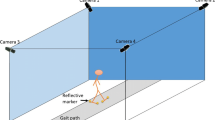Abstract
The aim of the research was to evaluate the results of NDT-Bobath method in gait re-education of adult patients after ischemic stroke using normalized parameters of gait. The investigation group consisted of 60 patients, all sufferers of an ischemic stroke, and participated in a rehabilitation program: 10 sessions of NDT-Bobath therapy through 2 weeks (ten days of the therapy). Normalized parameters of gait were calculated based on anthropometric measures of patients and their gait parameters (gait velocity, cadence and stride length) measured in every patient on admission (before the therapy) and after the last session of the therapy to assess rehabilitation effects. Results among patients involved in the research were as follows:
-
in normalized gait velocity: recovery in 42 cases (70 %), relapse in 10 cases (16,67 %), no measurable changes in 8 cases (13.33 %)
-
in normalized cadence: recovery in 39 cases (65 %), relapse in 16 cases (26.67 %), no measurable changes in 5 cases (8.33 %)
-
in normalized stride length: recovery in 50 cases (83.33 %), relapse in 4 cases (6.67 %), no measurable changes in 6 cases (10 %).
Observed statistically significant and favourable changes in health status of patients, described by normalized gait parameters, confirm effectiveness of the NDT-Bobath method.
Similar content being viewed by others
References
Błaszczyk B., Czernecki R., Prędota-Panecka H., Profilaktyka pierwotna i wtórna udarów mózgu, Studia Medyczne, 2008, 9, 71–75, (in Polish)
Członkowska A., Udar mózgu — perspektywy leczenia w Polsce w świetle osiągnięĆ światowych, Polski Przegląd Neurologiczny, 2005, 1, 1–7, (in Polish)
Członkowska A., Osiągnięcia w zakresie udaru mózgu, Medycyna po Dyplomie, 2005, Supl. 17, 5–11, (in Polish)
Palasik W., Nowe tendencje w terapii udaru niedokrwiennego, New trends in ischemic stroke therapy, Terapia, 2006, 1, 4–8, (in Polish)
Profilaktyka wtórna udaru mózgu, Rekomendacje grupy ekspertów Narodowego Programu Profilaktyki i Leczenia Udaru Mózgu, Neurol. Neurochir. Pol., 2003, Supl. 6, 17–43, (in Polish)
Muren M.A., Hütler M., Hooper J., Functional capacity and health-related quality of life in individuals post stroke, Top Stroke Rehabil., 2008, 15,1, 51–58
Murtezani A., Hundozi H., Gashi S., Osmani T., Krasniqi V., Rama B., Factors associated with reintegration to normal living after stroke, Med. Arh., 2009, 63,4, 216–219
Starsky A.J., Sangani S.G., McGuire J.R., Logan B., Schmit B.D., Reliability of biomechanical spasticity measurements at the elbow of people poststroke, Arch. Phys. Med. Rehabil., 2005, 86,8, 1648–1654
Platz T., Eickhof C., Nuyens G., Vuadens P., Clinical scales for the assessment of spasticity, associated phenomena, and function: a systematic review of the literature, Disabil. Rehabil., 2005, 27,1–2, 7–18
Brashear A., Zafonte R., Corcoran M., Galvez-Jimenez N., Gracies J.M., Gordon M.F., et al., Inter- and intrarater reliability of the Ashworth Scale and the Disability Assessment Scale in patients with upper-limb poststroke spasticity, Arch. Phys. Med. Rehabil., 2002, 83,10, 1349–1354
Bohannon R.W., Smith M.B., Interrater reliability of a modified Ashworth scale of muscle spasticity, Phys. Ther., 1987, 6, 206–207
Bromley I., Tetraplegia and paraplegia: a guide for physiotherapists, 6th ed., Churchill Livingstone, London, 2006
Davies P.M., Steps to follow: the comprehensive treatment of adult hemiplegia, 2nd ed., Springer, New York, 2000
Howle J.M., Neuro-Developmental Treatment Approach. Theoretical foundations and principles of clinical practice, Neuro-Developmental Treatment Association, Laguna Beach, 2003
Mayston M.J., Problem solving in neurological physiotherapy — setting the scene, In: Edwards S. (Ed.), Neurological physiotherapy — a problem solving approach, 2nd ed., Churchill Livingstone, London, 2001
Lennon S., Ashburn A., The Bobath concept in stroke rehabilitation: a focus group study of the experienced physiotherapists’ perspective, Disabil. Rehabil., 2000, 15, 665–674
Lennon S., Baxter D., Ashburn A., Physiotherapy based on the Bobath concept in stroke rehabilitation: a survey within the UK, Disabil. Rehabil., 2001, 6, 254–262
Bobath B., Adult hemiplegia: evaluation and treatment, 3rd ed., Heinemann Medical Books, London, 1990
Paci M., Physiotherapy based on the Bobath Concept for adults with post-stroke hemiplegia: a review of effectiveness studies, J. Rehabil. Med., 2003, 1, 2–7
Mikołajewska E., Przykład terapii chodu metodą NDT-Bobath u pacjenta z hemiplegią, Prakt. Fizjoter. Rehabil., 2010, 11, 16–20, (in Polish)
Mikołajewska E., Metoda NDT-Bobath w praktyce klinicznej, Praktyczna Fizjoterapia i Rehabilitacja, 2010, 11, 14–15, (in Polish)
Mikołajewska E., Metoda NDT-Bobath w usprawnianiu osób dorosłych: wprowadzenie do metody, Praktyczna Fizjoterapia i Rehabilitacja, 2010, 11, 8–13, (in Polish)
Mikołajewska E., Metoda NDT-Bobath w neurorehabilitacji pacjentów dorosłych, Wydawnictwo Lekarskie PZWL, Warsaw, 2011, (in Polish)
Lennon S., Gait re-education based on the Bobath concept in two patients with hemiplegia following stroke, Phys. Ther., 2001, 3, 924–935
Wall J.C., Kirtley C., Strategies for clinical gait assessment, Orthop. Phys. Ther. Clin. N. Am., 2001, 3, 35–54
Whittle M.W., Gait analysis: an introduction. 3rd ed., Butterworth Heinemann, Oxford-Waltham, 2002
Mikołajewska E., Analiza chodu pacjentów po udarze mózgu — rozwiązanie własne, Udar Mózgu Problemy Interdyscyplinarne, 2010, 12,1–2, 20–26, (in Polish)
Kirtley C., Whittle M.W., Jefferson R.J., Influence of walking speed on gait parameters, J. Biomed. Eng., 1985, 4, 282–287.
Kirtley C., CGA Clinical Gait Analysis available on Dr Kirtley’s website (http://www.clinicalgaitanalysis.com/)
Author information
Authors and Affiliations
Corresponding author
About this article
Cite this article
Mikołajewska, E. Normalized gait parameters in NDT-Bobath post-stroke gait rehabilitation. cent.eur.j.med 7, 176–182 (2012). https://doi.org/10.2478/s11536-011-0138-6
Received:
Accepted:
Published:
Issue Date:
DOI: https://doi.org/10.2478/s11536-011-0138-6




